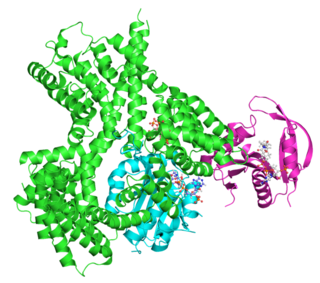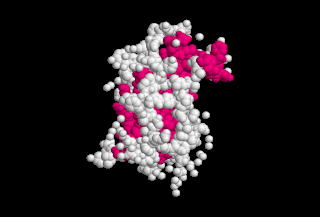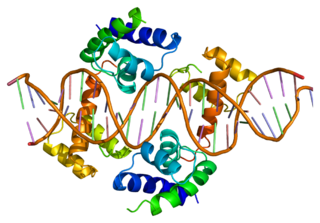Related Research Articles

Adrenocorticotropic hormone is a polypeptide tropic hormone produced by and secreted by the anterior pituitary gland. It is also used as a medication and diagnostic agent. ACTH is an important component of the hypothalamic-pituitary-adrenal axis and is often produced in response to biological stress. Its principal effects are increased production and release of cortisol and androgens by the cortex and medulla of the adrenal gland, respectively. ACTH is also related to the circadian rhythm in many organisms.

Growth hormone (GH) or somatotropin, also known as human growth hormone in its human form, is a peptide hormone that stimulates growth, cell reproduction, and cell regeneration in humans and other animals. It is thus important in human development. GH also stimulates production of IGF-1 and increases the concentration of glucose and free fatty acids. It is a type of mitogen which is specific only to the receptors on certain types of cells. GH is a 191-amino acid, single-chain polypeptide that is synthesized, stored and secreted by somatotropic cells within the lateral wings of the anterior pituitary gland.

Prolactin (PRL), also known as lactotropin and mammotropin, is a protein best known for its role in enabling mammals to produce milk. It is influential in over 300 separate processes in various vertebrates, including humans. Prolactin is secreted from the pituitary gland in response to eating, mating, estrogen treatment, ovulation and nursing. It is secreted heavily in pulses in between these events. Prolactin plays an essential role in metabolism, regulation of the immune system and pancreatic development.

Somatostatin, also known as growth hormone-inhibiting hormone (GHIH) or by several other names, is a peptide hormone that regulates the endocrine system and affects neurotransmission and cell proliferation via interaction with G protein-coupled somatostatin receptors and inhibition of the release of numerous secondary hormones. Somatostatin inhibits insulin and glucagon secretion.

Bovine somatotropin or bovine somatotrophin, or bovine growth hormone (BGH), is a peptide hormone produced by cows' pituitary glands.
Gonadotropins are glycoprotein hormones secreted by gonadotropic cells of the anterior pituitary of vertebrates. This family includes the mammalian hormones follicle-stimulating hormone (FSH) and luteinizing hormone (LH), the placental/chorionic gonadotropins, human chorionic gonadotropin (hCG) and equine chorionic gonadotropin (eCG), as well as at least two forms of fish gonadotropins. These hormones are central to the complex endocrine system that regulates normal growth, sexual development, and reproductive function. LH and FSH are secreted by the anterior pituitary gland, while hCG and eCG are secreted by the placenta in pregnant humans and mares, respectively. The gonadotropins act on the gonads, controlling gamete and sex hormone production.

Hypopituitarism is the decreased (hypo) secretion of one or more of the eight hormones normally produced by the pituitary gland at the base of the brain. If there is decreased secretion of one specific pituitary hormone, the condition is known as selective hypopituitarism. If there is decreased secretion of most or all pituitary hormones, the term panhypopituitarism is used.

Pituitary adenomas are tumors that occur in the pituitary gland. Most pituitary tumors are benign, approximately 35% are invasive and just 0.1% to 0.2% are carcinomas. Pituitary adenomas represent from 10% to 25% of all intracranial neoplasms and the estimated prevalence rate in the general population is approximately 17%.
Choh Hao Li was a Chinese-born American biochemist who discovered, in 1966, that human pituitary growth hormone (somatotropin) consists of a chain of 256 amino acids. In 1970 he succeeded in synthesizing this hormone, the largest protein molecule synthesized up to that time.
Releasing hormones and inhibiting hormones are hormones whose main purpose is to control the release of other hormones, either by stimulating or inhibiting their release. They are also called liberins and statins (respectively), or releasing factors and inhibiting factors. The principal examples are hypothalamic-pituitary hormones that can be classified from several viewpoints: they are hypothalamic hormones, they are hypophysiotropic hormones, and they are tropic hormones.
The prolactin receptor (PRLR) is a type I cytokine receptor encoded in humans by the PRLR gene on chromosome 5p13-14. It is the receptor for prolactin (PRL). The PRLR can also bind to and be activated by growth hormone (GH) and human placental lactogen (hPL). The PRLR is expressed in the mammary glands, pituitary gland, and other tissues. It plays an important role in lobuloalveolar development of the mammary glands during pregnancy and in lactation.

Human placental lactogen (hPL), also called human chorionic somatomammotropin (hCS) or human chorionic somatotropin, is a polypeptide placental hormone, the human form of placental lactogen. Its structure and function are similar to those of human growth hormone. It modifies the metabolic state of the mother during pregnancy to facilitate energy supply to the fetus. hPL has anti-insulin properties. hPL is a hormone secreted by the syncytiotrophoblast during pregnancy. Like human growth hormone, hPL is encoded by genes on chromosome 17q22-24. It was identified in 1963.

POU domain, class 1, transcription factor 1 , also known as POU1F1, is a transcription factor for growth hormone.

The prolactin-releasing peptide receptor (PrRPR) also known as G-protein coupled receptor 10 (GPR10) is a protein that in humans is encoded by the PRLHR gene.

Growth hormone 1, also known as pituitary growth hormone or simply as growth hormone (GH) somatotropin, is a protein that in humans is encoded by the GH1 gene.

Growth hormone 2 (GH2), also known more commonly as placental growth hormone (PGH) or growth hormone variant (GH-V), is a protein that in humans is encoded by the GH2 gene. It is produced by and secreted from the placenta during pregnancy, and becomes the predominant form of growth hormone (GH) in the body during this time. Its cogener is growth hormone 1 (GH1), or pituitary growth hormone.

Lactation describes the secretion of milk from the mammary glands and the period of time that a mother lactates to feed her young. The process naturally occurs with all sexually mature female mammals, although it may predate mammals. The process of feeding milk in all female creatures is called nursing, and in humans it is also called breastfeeding. Newborn infants often produce some milk from their own breast tissue, known colloquially as witch's milk.
Breast development, also known as mammogenesis, is a complex biological process in primates that takes place throughout a female's life.
A somatomammotroph or somatomammotrophic cell, also known as a somatolactotroph or somatolactotrophic cell, is a type of cell of the anterior pituitary gland that produces both somatotropin and prolactin. Cells that secrete only somatotropin or only prolactin are known as somatotrophs and mammotrophs, respectively.
The multigenic complex formed by the human growth hormone (hGH) and the human placental lactogen (hPL) takes part in the process of maternal and fetal metabolism regulation and the following growth and development of the fetus.
References
- ↑ Wallis M (1981). "The molecular evolution of pituitary growth-hormone prolactin and placental-lactogen - a protein family showing variable rates of evolution". J. Mol. Evol. 17: 10–18. doi:10.1007/bf01792419. S2CID 19939571.
- ↑ Kessler MA, Milosavljevic M, Zieler CG, Schuler LA (1989). "A subfamily of bovine prolactin-related transcripts distinct from placental lactogen in the fetal placenta". Biochemistry. 28 (12): 5154–5161. doi:10.1021/bi00438a036. PMID 2765528.
- ↑ Rand-Weaver M, Noso T, Muramoto K, Kawauchi H (1991). "Isolation and characterization of somatolactin, a new protein related to growth hormone and prolactin from Atlantic cod (Gadus morhua) pituitary glands". Biochemistry. 30 (6): 1509–1515. doi:10.1021/bi00220a010. PMID 1993170.
- ↑ Connor AM, Waterhouse P, Khokha R, Denhardt DT (1989). "Characterization of a mouse mitogen-regulated protein/proliferin gene and its promoter: a member of the growth hormone/prolactin gene superfamily". Biochim. Biophys. Acta. 1009 (1): 75–82. doi:10.1016/0167-4781(89)90081-X. PMID 2790033.
- ↑ Benedet S, Björnsson BT, Taranger GL, Andersson E (2008). "Cloning of somatolactin alpha, beta forms and the somatolactin receptor in Atlantic salmon: seasonal expression profile in pituitary and ovary of maturing female broodstock". Reprod. Biol. Endocrinol. 6: 42. doi: 10.1186/1477-7827-6-42 . PMC 2553077 . PMID 18793397.
- ↑ Benedet Perea, Susana (2008). Growth hormone and somatolactin function during sexual maturation of female Atlantic salmon. (Ph.D.) Department of Zoology/Zoophysiology, Göteborg University, Box 463, SE-405 30 Göteborg, Sweden
- ↑ Carlacci L, Chou KC, Maggiora GM (1991). "A heuristic approach to predicting the tertiary structure of bovine somatotropin". Biochemistry. 30 (18): 4389–4398. doi:10.1021/bi00232a004. PMID 2021631.